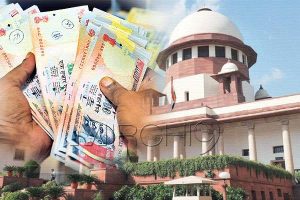Top Court to review Modi govt’s demonetisation exercise
 NEW DELHI: The Supreme Court said on Wednesday it is aware of the “Lakshman Rekha” on judicial review of government policy decisions but will have to examine the 2016 demonetisation decision to decide whether the issue has become a mere “academic” exercise.
NEW DELHI: The Supreme Court said on Wednesday it is aware of the “Lakshman Rekha” on judicial review of government policy decisions but will have to examine the 2016 demonetisation decision to decide whether the issue has become a mere “academic” exercise.
A five-judge bench headed by Justice S A Nazeer said observing that when an issue arises before a constitution bench, it is its duty to answer, a five-judge bench headed by Justice S. A. Nazeer directed the Centre and the Reserve Bank of India to file a comprehensive affidavit on the petitions challenging demonetisation of ₹500 and ₹1,000 currency notes.
Attorney General R Venkataramani submitted that unless the Act on demonetisation is challenged in a proper perspective, the issue will essentially remain academic.
The High Denomination Bank Notes (Demonetisation) Act was passed in 1978 to provide in public interest for demonetisation of certain high denomination bank notes in order to check illicit transfer of money harmful to the economy which such currency notes facilitate.
The top court said in order to declare whether the exercise is academic or in fructuous, it needs to examine the matter since both sides are not agreeable.”In order to answer that issue, we will have to hear and give an answer whether it’s academic, not academic or beyond the scope of judicial review. The point in the case is the government policy and its wisdom which is one aspect of the matter.
“We always know where the Lakshman Rekha is, but the manner in which it was done has to be examined. We have to hear the counsel to decide that,” the bench, also comprising Justices B R Gavai, A S Bopanna, V Ramasubramanian, and B V Nagarathna said.
Solicitor General Tushar Mehta, appearing for the Centre, said the court’s time should not be “wasted” on academic issues. Objecting to Mr Mehta’s submission, senior lawyer Shyam Divan, representing petitioner Vivek Narayan Sharma, said he was surprised at the words “waste of constitutional bench’s time” as the earlier bench had said these cases must be placed before a constitution bench. Senior advocate P Chidambaram, appearing for one of the parties, said the issue has not become academic and it has to be decided by the top court.He said this kind of demonetisation requires a separate act of Parliament.
On December 16, 2016, a bench headed by then Chief Justice TS Thakur had referred the question of the validity of the decision and other issues to a larger bench of five judges for authoritative pronouncement. It had framed various questions in the reference order to be adjudicated by the five-judge bench which included whether the notification dated November 8, 2016 is ultra vires provisions of the Reserve Bank of India Act, 1934 and does the notification contravene the provisions of Article 300 (A) of the Constitution. Article 300(A) says no person shall be deprived of his property save by the authority of law.
“Demonetisation” is an economic activity in which the government eliminates the old currency and introduces the new currency. When black money increases and becomes a threat to the economy, this method is used to remove it. Those who have black money, they are not able to muster the courage to take new currency in exchange for it and the black money itself gets destroyed. It was used by the Prime Minister of India Narendra Modi on 8 November 2016. From this day the old 500 and 1000 rupees currency were discontinued and new currencies were introduced.
The High Value Bank Notes (Demonetization) Act was passed in 1978 to put certain high denomination banknotes out of circulation in the public interest and to check illegal transfer of money harmful to the economy. The first currency was demonetised in 1978 by the fourth Prime Minister of India, Morarji Desai, in which 1000 and 5000 notes were discontinued.
(With Agency Inputs).

